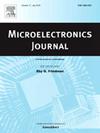Impact of the collector structure on the performance of the insulated gate bipolar transistor
IF 1.9
3区 工程技术
Q3 ENGINEERING, ELECTRICAL & ELECTRONIC
引用次数: 0
Abstract
Various types of collectors have been reported for insulated-gate bipolar transistors (IGBTs). Despite their importance however, a thorough study on the influence of the collector structure on the performance of the IGBT is lacking in literature. In this work, the impact of the collector structure on mainly the DC performance of the IGBT has been studied through extensive TCAD simulations. This is done via the Gummel number of the collector, which is used for three types of collector structures (i.e. silicon, silicon-germanium, and pure boron). These structures are interesting because they can extend the Gummel numbers to respectively smaller and higher values, and potentially also reduce the process complexity. Finally, an analytical expression between the saturation voltage and stored charge, i.e. the trade-off curve, has been derived, where the stored charge is a good measure for the switching losses. Therefore, this analytical expression can be employed to estimate the switching losses directly from device properties.
集电极结构对绝缘栅双极晶体管性能的影响
各种类型的集电极已被报道用于绝缘栅双极晶体管(igbt)。然而,尽管它们很重要,但文献中缺乏对集电极结构对IGBT性能影响的深入研究。在这项工作中,通过广泛的TCAD模拟研究了集电极结构对IGBT直流性能的影响。这是通过集热器的Gummel数来完成的,它用于三种类型的集热器结构(即硅、硅锗和纯硼)。这些结构很有趣,因为它们可以将Gummel数分别扩展到更小和更高的值,并且还可能降低过程的复杂性。最后,导出了饱和电压与存储电荷之间的解析表达式,即权衡曲线,其中存储电荷是衡量开关损耗的一个很好的指标。因此,这个解析表达式可以直接从器件性质来估计开关损耗。
本文章由计算机程序翻译,如有差异,请以英文原文为准。
求助全文
约1分钟内获得全文
求助全文
来源期刊

Microelectronics Journal
工程技术-工程:电子与电气
CiteScore
4.00
自引率
27.30%
发文量
222
审稿时长
43 days
期刊介绍:
Published since 1969, the Microelectronics Journal is an international forum for the dissemination of research and applications of microelectronic systems, circuits, and emerging technologies. Papers published in the Microelectronics Journal have undergone peer review to ensure originality, relevance, and timeliness. The journal thus provides a worldwide, regular, and comprehensive update on microelectronic circuits and systems.
The Microelectronics Journal invites papers describing significant research and applications in all of the areas listed below. Comprehensive review/survey papers covering recent developments will also be considered. The Microelectronics Journal covers circuits and systems. This topic includes but is not limited to: Analog, digital, mixed, and RF circuits and related design methodologies; Logic, architectural, and system level synthesis; Testing, design for testability, built-in self-test; Area, power, and thermal analysis and design; Mixed-domain simulation and design; Embedded systems; Non-von Neumann computing and related technologies and circuits; Design and test of high complexity systems integration; SoC, NoC, SIP, and NIP design and test; 3-D integration design and analysis; Emerging device technologies and circuits, such as FinFETs, SETs, spintronics, SFQ, MTJ, etc.
Application aspects such as signal and image processing including circuits for cryptography, sensors, and actuators including sensor networks, reliability and quality issues, and economic models are also welcome.
 求助内容:
求助内容: 应助结果提醒方式:
应助结果提醒方式:


